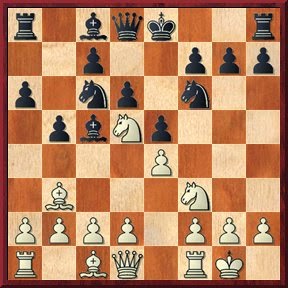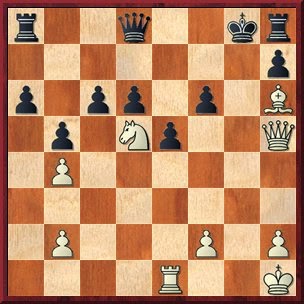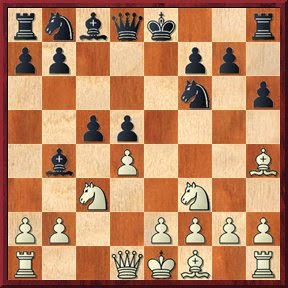Back from the Macedonian League, where my team won the title (while my result was mediocre, I compensated for that by drawing the crucial game that secured the title) I can now take a look at the last 3 rounds of the Dortmund tournament.
Caruana easily survived his clash with Kramnik without too many problems and then cruised on to win the tournament after winning one more game, against Adams in round 6. An impressive result for Caruana, who scored 100% with white, won a 7-round tournament with 1.5 point margin, crossed the 2800-mark on the live list and reached number 3 in the world!
In his game with Kramnik, he chose Smyslov’s move 6…b6 in the Fianchetto Grunfeld (almost never played nowadays) and solved his opening problems easily. The structure resembled the Exchange Slav and with patient play Caruana exchanged almost all pieces and drew, something he definitely welcomed after 2 losses in a row with black against Kramnik.
Leko beat Naiditsch in a structure with fixed centre where white had the better bishop. A very smooth and impressive performance by Leko and a game that wasn’t decided by a direct blunder – quite a rarity these days! The game reminded me of the Botvinnik-Petrosian, 14th game from their 1963 match, even though there white had a knight vs bishop, but the manner of slowly improving the position was very similar.
Ponomariov got some advantage in the popular (in this tournament) Breyer against Baramidze (they followed Spassky-Karpov, 10th game of their 1974 Candidates match until move 20) and after the latter’s inexplicable 22…Re7 won the pawn on e5. I’m pretty sure the Ponomariov of old would have wrapped things up from that moment, but what followed was a game full of missed opportunities for Ponomariov. Eventually the German saved the game, something the Germans really enjoy doing!
Meier must have been surprised by the first-ever Slav by Adams and he got outplayed in the middlegame as when the position opened up the king safety and pawn weaknesses were more important than the bishop pair. Adams missed a good chance before the time control (36…Rd4 would have been strong) and after that the German managed to save the game. Nothing surprising there.
In round 6 Caruana secured his victory in the tournament by beating last year’s winner Adams with white in the Berlin. A white win in the Berlin is a rare occurence in modern play (a black win even rarer), but it’s interesting to note that the structure and the piece arrangement (knight and bishop vs a pair of bishops) was very similar to Caruana’s win against Carlsen from the Gashimov Memorial. It’s obvious that this is the type of position black Berlin players must try to avoid, yet Adams was somehow tricked into it! Far from it being lost, it’s just unpleasant, as Adams had better ways of playing, but the fact that he didn’t find them and ended up losing convincingly shows the dangers the position holds for black.
Baramidze and Meier played a well-known drawing line in the Catalan. Nothing much to add there.
Naiditsch beat Ponomariov, who tried to improve upon his rapid game with Karjakin from 2013. His improvement of 18…Nh5 brought him acceptable play, however the game was decided by a blunder by Ponomariov on move 28, when he should have retaken with the other knight on c5, keeping control of the e5-square. Games are almost always lost because of blunders (that’s why I was impressed by Leko’s win against Naiditsch from the previous round) and this one was no exception. After missing a win in the previous round the punishment came swiftly for Ponomariov.
Kramnik tried his latest pet-move 4 e3 move against Leko’s Queen’s Indian, but got nowhere with it. (He also used 4 e3 against Aronian’s Queen’s Gambit in the Candidates.) In a symmetrical position pieces were exchanged systematically, leading to an expected draw.
The last round saw Leko draw Caruana in one of the most fashionable Berlin deviations, not a very exciting game where the result suited both players perfectly.
Adams repetead the line Ponomariov used against Baramidze and the latter deviated on move 18 by playing 18…h6. Once more he allowed the exchange on c5, only this time he didn’t blunder a pawn. I don’t know what positives he saw after this exchange as I really don’t like the look of those doubled pawns on c4 and c5, plus white’s protected passed pawn on d5, plus white’s initiative on the queenside. The comp finds an amazing resource for black on move 25, 25…h4 26 Nf1 and now 26…Bd5, sacrificing a piece for 2 pawns. A very tricky thing to see and decide upon in a practical game where you don’t think drastic measures are necessary. But on that very move Baramidze sacrificed a pawn (or perhaps just gave it away, as there wasn’t any compensation for it) and went down unceremoniously. The win brought Adams his first win and a 50% score, while this was Baramidze’s 3rd loss.
Naiditsch chose a dubious line (14…dc) in the KID against Meier and as it’s usually the case he backed it up with some computer analysis. But that didn’t change the verdict that the position was dubious! Meier got a big advantage and yet in a complicated and unknown position he let it slip several times. A fluctuating complex endgame came down to a position with a rook and 3 pawns each plus opposite coloured bishops. Naiditsch was still the one who had to look for the draw and he was very close, but on move 50, instead of 50…c3 he chose 50…Rd4 and after 51 Kc3 white got a blockading king with a strong passed pawn on the a-file. He put both to good use and there were no more chances for Naiditsch. This win brought Meier to shared 2nd, possibly the biggest success in his career.
Ponomariov chose the same Berlin deviation Leko chose against Caruana, but instead of the usual drawing lines Kramnik chose the more complex 7…Nf5, something he chose against Kobalia in the World Cup. They followed the recent Guseinov-Malakhov game from the World Rapid Championship and Kramnik introduced the new 11…Nce7. He got a good game, as he usually does after the opening and his play in the middlegame was also quite strong, managing to put pressure on Ponomariov. But somewhere around move 25 he lost the plot and suddenly lost the pawn on e4. This time Ponomariov wrapped things up (perhaps after 6 games he finally got the necessary practice?!), leaving Kramnik with a miserable -2 score.
After the tournament I read a tweet by Eljanov, who said he was sorry for Kramnik and this is an alarming sign for Big Vlad. The strong never evoke pity, they evoke fear. And if Kramnik starts to evoke pity, that means that people don’t fear him as he’s not strong anymore… And coming down to 2760 and number 10 on the live list plus a third (Candidates and Stavanger being the other 2) bad tournament in a row – something is definitely going on with the former world champion! All this makes me eager to see how he reacts to all these setbacks at the Olympiad, where I don’t expect his undisputed status of number 1 player in the Russian team will be affected.
The Dortmund tournament is another one in the string of recent tournaments where a young player wins it without giving a chance to the older participants. From the supertournaments this year only the Candidates was won by a player from another generation, everything else was won by Aronian (Wijk) Carlsen (Zurich, Gashimov Memorial), Karjakin (Stavanger) and Caruana (Dortmund) and if you count the ACP Bergamo, Wesley So. The domination of these players is already obvious and So is firmly on his way to the Top 10. We’re witnessing a change of generations and these are the players who will dominate in the foreseeable future. Since their chess is very exciting, I don’t really mind that!
























